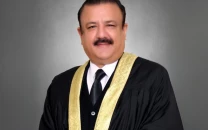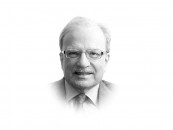Higher direction of war
Why Pakistan's Joint Chiefs System failed

The Joint Chiefs of Staff military system first came into being in the US in 1947. It saw a major overhaul and a redefinition through the Goldwater-Nichols Act of 1986. Failure of the Grenada invasion rekindled failures from the past, especially in the Vietnam War, when it was led and fought from the Oval Office by President Lyndon Johnson and his firebrand Secretary of War, Robert McNamara.
Together, they would pore over maps, study the state of war thousands of miles away, and allocate missions to American forces in Vietnam under their chosen commander of the forces, General Westmoreland. Eventually, he relinquished command under the weight of speculative performance. Post-war analysis suggested that the absence of professional and institutional advice to the President was the key to America's loss of face and the eventual shameful defeat.
The Joint Chiefs system was remodeled to provide the President with active advice on all military matters. The Chairman led a Committee consisting of the four Service Chiefs from the Army, Air Force, Navy and the Marines. Below the President, directly answerable to him on all operational matters, were regionally appointed unified force commanders — responsible for all military forces in their geographical area, eliminating service-specific command structure. They held the same rank as the respective chiefs of the services on the Joint Chiefs Committee. Respective geographical commands acted in response to direct Presidential orders on all operational matters. These actions followed directives advised by the Joint Chiefs to the President in Washington and authorized by Congress.
A better check and balance system perhaps is not possible. The respective Chiefs of Staff of the four services were primarily responsible for development, equipment, human resource — training, promotion and postings, and advising the President on all matters related to his service. Direct command of troops was taken away from the Chiefs of respective services and placed under the regional/geographical commanders. They would, however, coordinate with their respective service chiefs for meeting equipment and manpower requirements and other organisational matters.
Division of responsibility was thus complete, and no single individual carried the force of the power residing in the composite military forces spread under various geographical denominations. Each force was complete, with its own components of an air force, army, and navy. Marines were added wherever an operational requirement arose and a need existed. Each service component commander in a geographical command was responsible for the operational preparedness and readiness of the force under his command. A geographical commander could belong to any of the four services.
The rest of the world simply borrowed the idea to suit it to its peculiar environment and needs. Pakistan picked up the system in 1974 under Zulfikar Ali Bhutto. If the US had the ignominy of failing in wars for such restructuring to occur, Pakistan's loss to India in the Bangladesh War in 1971 found the military at its weakest when Bhutto restructured the military system. His aims were patently political, though more could be said in justification.
Bhutto wished to take the direct command of the troops away from the army chief who, he thought, exercised an oversized influence in matters of the state because of that power. He had seen both Ayub Khan and Yahya Khan apply their respective martial law. Except that the system never really changed. Despite the Joint Chiefs system in place, service chiefs continued to act as commanders-in-chief of their respective forces.
A lack of operational coordination between the three services could also be cited as a reason behind creating a Joint Chiefs mechanism. When the then Air Force Commander, Nur Khan, learnt that Operation Gibraltar, in 1965, had been launched as a de facto prelude to the actual war that followed a few weeks later, he confronted Ayub Khan to know the facts.
Ayub Khan reluctantly conceded, but Nur Khan's major lament was that he needed to know, for he had to get his force prepared for war if it came. That is exactly how events proceeded. It was a chance occurrence that he learnt of it, and had to make the effort to know of it. Ditto in 1971: the air and naval chiefs learnt of the beginning of war on the western front on the regular 7 O'clock news on the radio. The facts and the inherent political intent gave good reason to Bhutto, thus, to introduce the Joint Chiefs system in the military.
Except that it did not work as expected. No army chief, worth his salt, was willing to part with his inherent power of directly commanding his troops, and hence his immense heft. And even though most Chairmen of the Joint Chiefs came from the army, barring an odd exception, the army as an organisation never really deferred to them or their position. A Joint Chiefs Committee meeting was held sporadically and mostly as a pro forma event, if at all.
Some who tried enforcing their position may have been a little more regular, but none could ever deliver a substantive policy agreement, or a joint direction of war, or matters related to it. The three service chiefs, who would meet informally in the Chairman's office, perhaps agreed on a common stance on a national/political issue that the army chief, not the Chairman, barring an unusual exception, would duly convey to the government. Most Chairmen quietly acquiesced to this 'ground reality'.
Similarly, operations were primarily a service function and not brought before the chairman for discussion or concurrence, even if those were being discussed between services for coordination and joint planning. When the Strategic Plans Division (SPD) came of age, it was placed in the care of the Chairman for some functions, even if operational control and major development goals still rested with the army chief — who sometimes was also the President — whose concurrence was considered essential.
The chairman of the Joint Chiefs was thus mostly on the lookout for what else he could get under his wing as a function. Joint Services institutions, like the ISPR and the ISI, remained outside his purview. He would try getting the Air Force and the Navy to kowtow to him and his authority, but was always rebuffed. The army never responded to his attempts to gain some insight.
Sadly, it turned into a listless, impotent and a mere seat-warming spot for someone who needed to be pacified for being considered unsuitable to lead the army. General Musharraf used the spot to appease some of his cronies. One arrogated to himself the task of the chief diplomat, exercising influence over an odd additional secretary of the foreign office to brief him periodically. Most Chairmen, willy-nilly, agreed to the protocol and lived with it.
It was a supernumerary position of a four-star which could never realise its purpose, yet stayed on for five decades, giving governments and army chiefs the option to fill a spot to pacify or appease. It was time for it to be abolished, even if some were worthy occupants of the office. What we replace it with must be more functional and profitable for the cost it will incur.













COMMENTS (1)
Comments are moderated and generally will be posted if they are on-topic and not abusive.
For more information, please see our Comments FAQ